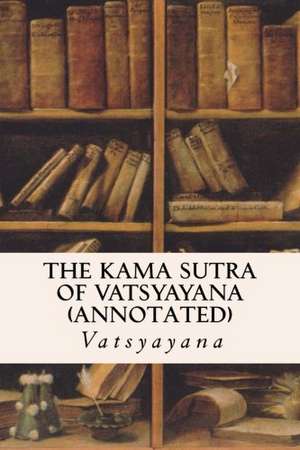The Kama Sutra of Vatsyayana (Annotated)
Autor Vatsyayanaen Limba Engleză Paperback
Preț: 57.09 lei
Nou
10.93€ • 11.36$ • 9.02£
Carte disponibilă
Livrare economică 22 martie-05 aprilie
Specificații
ISBN-10: 1518832237
Pagini: 178
Dimensiuni: 152 x 229 x 10 mm
Greutate: 0.25 kg
Editura: CreateSpace Independent Publishing Platform
Descriere
The Kama Sutra is an ancient Indian Hindu text widely considered to be the standard work on human sexual behavior in Sanskrit literature written by Vatsyayana. A portion of the work consists of practical advice on sexual intercourse. It is largely in prose, with many inserted anustubh poetry verses. "Kama" which is one of the four goals of Hindu life, means desire including sexual desire, the latter being the subject of the textbook, and "sutra" literally means a thread or line that holds things together, and more metaphorically refers to an aphorism (or line, rule, formula), or a collection of such aphorisms in the form of a manual. Contrary to western popular perception, the Kama Sutra is not exclusively a sex manual; it presents itself as a guide to a virtuous and gracious living that discusses the nature of love, family life, and other aspects pertaining to pleasure-oriented faculties of human life. The Kama Sutra, in parts of the world, is presumed or depicted as a synonym for creative sexual positions; in reality, only 20% of the Kama Sutra is about sexual positions. The majority of the book, notes Jacob Levy, is about the philosophy and theory of love, what triggers desire, what sustains it, and how and when it is good or bad. The Kama Sutra is the oldest and most notable of a group of texts known generically as Kama Shastra. Historians believe the Kama Sutra to have been composed between 400 BCE and 200 CE. 10] John Keay says that the Kama Sutra is a compendium that was collected into its present form in the 2nd century. In the preface of the Kama Sutra, Vatsyayana cites the work of previous authors based on which he compiled his own Kama Sutra. He states that the seven parts of his work were an abridgment of longer works by Dattaka (first part), Suvarnanabha (second part), Ghotakamukha (third part), Gonardiya (fourth part), Gonikaputra (fifth part), Charayana (sixth part), and Kuchumara (seventh part). Vatsyayana's Kama Sutra has 1250 verses, distributed over 36 chapters, which are further organised into seven parts: 1. General remarks Five chapters on contents of the book, three aims and priorities of life, the acquisition of knowledge, conduct of the well-bred townsman, reflections on intermediaries who assist the lover in his enterprises. 2. Amorous advances/sexual union Ten chapters on stimulation of desire, types of embraces, caressing and kisses, marking with nails, biting and marking with teeth, on copulation (positions), slapping by hand and corresponding moaning, virile behaviour in women, superior coition and oral sex, preludes and conclusions to the game of love. It describes 64 types of sexual acts. 3. Acquiring a wife Five chapters on forms of marriage, relaxing the girl, obtaining the girl, managing alone, union by marriage. 4. Duties and privileges of the wife Two chapters on conduct of the only wife and conduct of the chief wife and other wives. 5. Other men's wives Six chapters on behaviour of woman and man, how to get acquainted, examination of sentiments, the task of go-between, the king's pleasures, behaviour in the women's quarters. 6. About courtesans Six chapters on advice of the assistants on the choice of lovers, looking for a steady lover, ways of making money, renewing friendship with a former lover, occasional profits, profits and losses. 7. Occult practices Two chapters on improving physical attractions, arousing a weakened sexual power.
